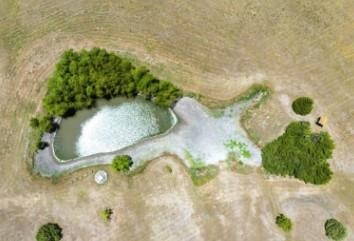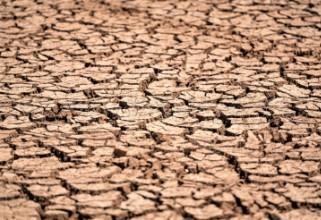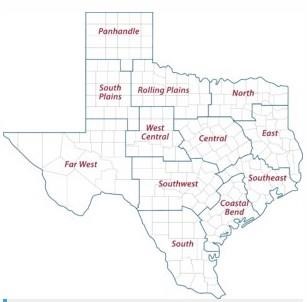By Adam Russell
Rainfall across Texas and cooler temperatures provided agricultural producers some relief from drought and extreme heat over recent weeks, but most areas remain in a moisture deficit, according to the Texas state climatologist and Texas A&M AgriLife Extension Service agronomists.
John Nielsen-Gammon, Ph.D., state climatologist in the Texas A&M College of Geosciences Department of Atmospheric Sciences, said most areas of the state received above-average rainfall during August but were still behind average rainfall amounts for the year.

Low stock tank levels around the state were a major concern for cattle producers around the state. While rainfall across Texas helped many areas, surface water availability remained an issue as drought conditions continued.
“We’ve seen drought contraction across the state, and last week’s rainfall should show improvement in the upcoming drought monitor later this week,” Nielsen-Gammon said. “But the rain is over for now. It looks like we’re now entering a dry stretch and have seen all the improvement we are going to see for a while.”
AgriLife Extension agronomists Reagan Noland, Ph.D., San Angelo; Jourdan Bell, Ph.D., Amarillo; and Ronnie Schnell, Ph.D., Bryan-College Station, said the rains helped, but noted their respective regions were still gripped by drought.
The most recent Texas drought monitor map produced by the National Drought Mitigation Center at the University of Nebraska shows reduced drought conditions around the state. The Drought Severity and Coverage Index, DSCI, which ranges from 0-500 and calculates the cumulative drought data for an area, showed the drought peaked at 380 on Aug. 8. The DSCI was 251 on Sept. 1.
Sporadic rainfall across Texas
Nielsen-Gammon said rainfall amounts were highly variable across much of the state. The wettest parts included a swath between Del Rio and the Lower Rio Grande Valley and the area between Fort Worth and the Arkansas/Louisiana border. The Texas Panhandle picked up the least amount of precipitation over the past 30 days.
The East Texas town of Zavalla between Lufkin and Jasper received the most rain during the month – 17.65 inches, Nielsen-Gammon said. Ferris, just south of Dallas, reported 16.65 inches while Corpus Christi and Houston both picked up more than 14 inches.

Crop field shows cracks in the soil from prolonged drought and extreme heat.
Encinal, north of Laredo, received 13.39 inches of rain, while Laredo reported almost 11 inches. Kent, a historically arid location in West Texas, north of Alpine, received more rainfall – 13.67 inches – than its average annual amount – 13.06 inches – between Aug. 15 and Sept. 4, Nielsen-Gammon said.
Noland said an important aspect of the recent weather was that the storm systems delivered cooler temperatures and cloudy days along with the rainfall. That contrasted to the limited rainfall received earlier in May and June, which was quickly lost to hot and windy conditions.
Areas around San Angelo received 1.5-9 inches of rain, and temperatures dropped into the upper 80s for daytime highs and 60s at night with cloudy days.
“I had 2 inches of rain on a field in late May that never infiltrated more than 3 or 4 inches down and had dried out completely within a couple days,” he said. “This time the rain was able to soak in, although the subsoil is still depleted. In many areas, we have decent moisture down to 6 or 8 inches, but below that is still dry. We’re still in an extreme moisture deficit, and it will take repeat rain events to change that.”
Weather pattern forecast still drier than normal
Nielsen-Gammon said a La Niña weather pattern is expected to hold through fall and winter, which means below average precipitation and above-average temperatures for Texas historically. The above-normal expectations for hurricanes and tropical storms could deliver moisture, but those storms typically bring destruction as well.
“We haven’t reached peak hurricane season, and we are up to ‘E’ with a few storms brewing, but it seems we’ve avoided a very active season,” he said. “It’s even more important that no hurricane landfalls have occurred. We’re better off with a widespread rain to break the drought, but weather patterns don’t appear to be cooperating following the second hottest summer on record.”
The arid conditions took their toll on most dryland crop acres, and irrigated fields struggled to keep up with plant water demands over the course of the growing season, according to numerous AgriLife Extension reports.
Bell said the recent rainfall was in time to help finish out irrigated crops like corn and grain sorghum, which are in the kernel fill stage, and should benefit boll development in cotton.
But the rainfall amounts around the Texas Plains were scattered and variable, she said. In areas that received heavier rains, the higher amounts in a short time did not allow for incorporation into the soil profile.
“Where higher rates were received, rainfall rates were often in excess of the soil infiltration rate so the rainfall was not as efficient as it would have been if received over several days,” she said.
Sunny days and higher temperatures also followed storm systems in the Texas Plains, she said.
Rainfall improved soil moisture, but not enough
While the rainfall will likely help established crops mature to harvest, Bell said there was not enough to build up the soil moisture to establish and support a wheat crop. Wheat fields were being planted, but where fields were being plowed, she said there was not enough moisture to germinate the crop.
Schnell said most areas in his region received 2-4 inches of rainfall, while some areas picked up several inches more. The moisture will help recharge the soil moisture profile and producer optimism but was far from enough to break the drought.
All warm-season crops were harvested or beyond any stage where moisture would benefit them, he said. But the rains should help cool-season small grains like oats and wheat. Pastures and rangelands were already showing signs of improvement and should help grazing and late-season hay production as well.
“Right now, producers are glad for the rain and cooler temperatures, but when you hear the long-term outlook is on the drier side, it’s something we have to keep in mind as we plan for next season’s crop,” Schnell said. “Good grain and commodity prices add to the optimism, but input costs are high as well, so it’s about having really good yields along with really good prices, and we need the weather to cooperate for that to happen.”
AgriLife Extension district reporters compiled the following summaries:

A map of the 12 Texas A&M AgriLife Extension districts
CENTRAL
Weather brought cooler temperatures and much-needed rain to the district. Rainfall was sporadic with trace amounts up to 10 inches reported across the district. Soil moisture levels remained short in most counties. High humidity helped hold moisture in the ground. Pastures were greening up nicely, but more rain was needed to make a dent in the drought conditions. Despite improvement, most rangeland and pastures were in poor overall condition. Livestock conditions were fair. About one-third of the cotton had been harvested with the remainder showing extensive resprouting quality decline.
ROLLING PLAINS
Temperatures were cooler. Most areas received some rain, but amounts ranged from a trace up to 4 inches. Producers were preparing to plant wheat in areas that received good rainfall, but soil remained too dry to plant in many areas despite rainfall. Pastures and rangeland conditions were improving following rainfall, but not enough was received to reduce supplemental feeding or increase stocking rates. The rainfall was expected to influence cattle culling for the near future. Producers were hopeful improved pastures would provide at least one more hay cutting.
COASTAL BEND
Scattered rainfall improved rangeland and pasture conditions, but despite the much-needed rain, drought conditions persisted. Soggy fields halted most fieldwork, except for the rice harvest, which was almost complete. Cotton harvest was mostly complete as well. Producers anticipated a good hay cutting when conditions dry out. Fresh growth was at high risk of fall armyworm damage, and producers were monitoring pastures. Some hay producers had already sprayed for fall armyworms at treatment threshold. Livestock were in good condition with prices steady to higher.
EAST
The district looked much better after recent rains. Pasture and hay meadows improved enough to potentially get another cutting of hay. Pasture and rangeland conditions were fair to good. Subsoil conditions were short to adequate, and topsoil conditions were adequate. Water levels in creeks and ponds rose. There were reports of armyworms and producers treating pastures for them. Livestock conditions were fair to good with some supplementation taking place.
SOUTH PLAINS
Temperatures were cooler, and more rain fell over the past week. Areas received 1-5 inches across the district. Parts of the district missed good rainfall, but many received enough to fill stock tanks and improve pasture and rangeland conditions. Moisture was expected to help winter wheat and plantings were expected to begin soon. Cattle were in good condition.
PANHANDLE
Crop conditions in some areas improved due to milder temperatures and rain. Soil moisture levels were adequate in most counties, and rangeland and pasture conditions were fair. Some early wheat plantings started for potential grazing opportunities. Irrigation was winding down on many corn fields as they matured. Silage harvest was underway. Some grain sorghum fields were starting to color.
NORTH
Topsoil moisture throughout the district was reported to be adequate. Temperatures were cooler and some counties reported 2-4 inches of rainfall. Cotton looked decent. Soybean fields not harvested for hay still looked poor. Pastures recovered well, and Bermuda grass bounced back and was actively growing.
FAR WEST
Good rains fell throughout the district, with totals ranging from trace amounts to 8 inches. Conditions were also cooler and cloudy. Rangeland conditions were greening up with new growth, but some overgrazed pastures will take more time and rain to bounce back. Most irrigation wells were turned off. Cotton bolls were starting to open, and opening was expected to pick up considerably once warm weather returned. Winter wheat plantings were expected to follow the rainfall depending on moisture. Planted hay grazer was emerging, and some was expected to be cut and baled. Heavy rains were hurting agriculture production around El Paso. Wet conditions were delaying alfalfa cutting and baling and negatively impacting management of irrigated crop fields. Soggy conditions were also delaying work in pecan orchards or equipment was leaving ruts, which may impact production. The pecan crop looked decent.
WEST CENTRAL
Much-needed rainfall occurred again, but totals varied depending on location. Stock tanks caught some runoff but were still in bad shape. Pastures were greening up and will provide decent grazing for livestock soon. Small grain plantings will start soon for grazing. Nearly all cotton fields were zeroed out and shredded or plowed.
SOUTHWEST
Spotty showers delivered rainfall, but some areas received more than others with up to 6 inches reported. Pasture and rangeland conditions improved. Supplemental feeding and selling of livestock continued but slowed in some areas with the recent rains. Cattle sale numbers were down significantly. Cotton harvest neared completion.
SOUTH
Soil moisture levels were short to adequate. Many areas received rainfall over recent weeks with average amounts ranging from 1-2 inches and isolated areas receiving up to 10 inches. More rainfall was in the forecast. Temperatures warmed back up following a cool spell that accompanied storm systems. Cotton harvest was underway in some areas and complete in others, while some fields around the district ranged from flowering to the boll-opening stage. Cotton stalk clearing was underway in some fields. Peanut fields continued to progress. Strawberry fields were prepared for planting. Pastures and rangeland were greening up, and forage conditions were improving rapidly in some areas. There were reports of mealy bugs and armyworms in pastures. Bermuda grass pastures looked good with some fields ready for cutting and baling but too wet for harvesting. Hay producers were replanting hay grazer. Livestock conditions were improving, and cattle prices were consistent as sale volumes decreased. Ranchers were still providing supplemental feed to livestock and deer. Producers were preparing fields for cool-season small-grain planting. Irrigation slowed in citrus and sugarcane. Dove season was in full swing.
Source : tamu.edu